Configuration
🧩 Overview
Bot configuration help us to allow the user to customize the bot corresponding to the width, name, avatar and logo of the bot. Bot configuration screen is designed to simplify the process of creating and configuring bots tailored to your specific business needs. Here, you can create, edit, set default, and delete your custom bots.
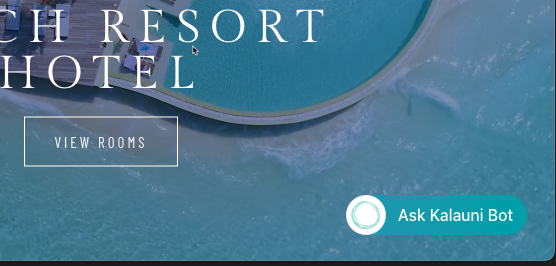
🛠️ Step 1 Create a Configuration
Go to the Agent, select the Controls menu from the left navigation panel, and click on the Bot menu to create a new bot configuration.
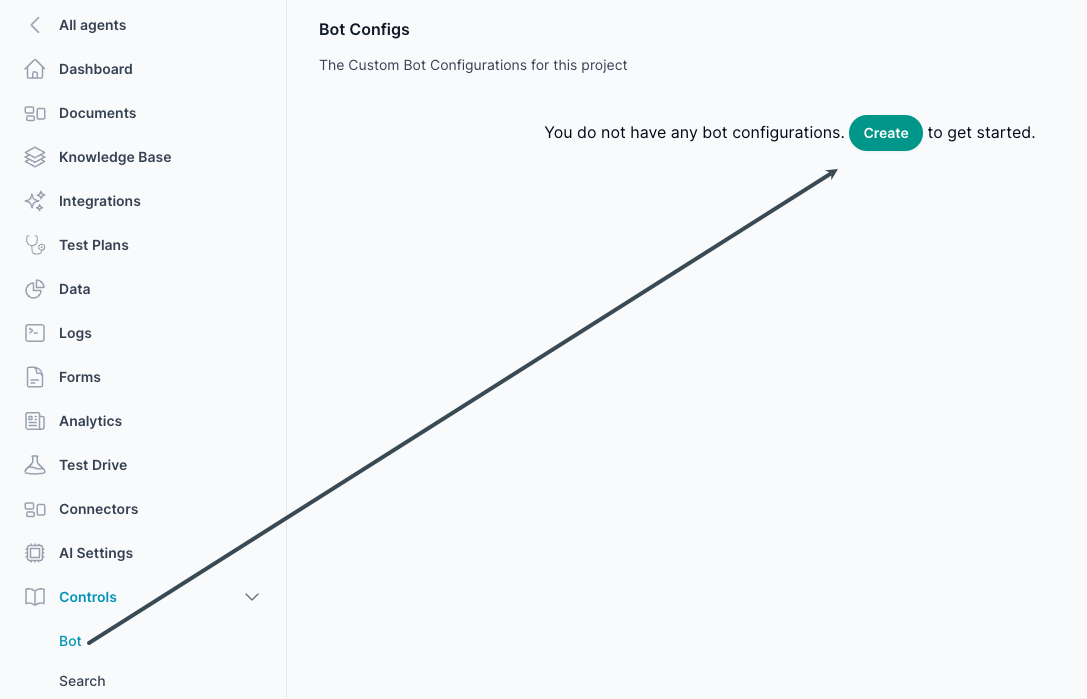
🛠️ Step 2 Name your configuration & Theme
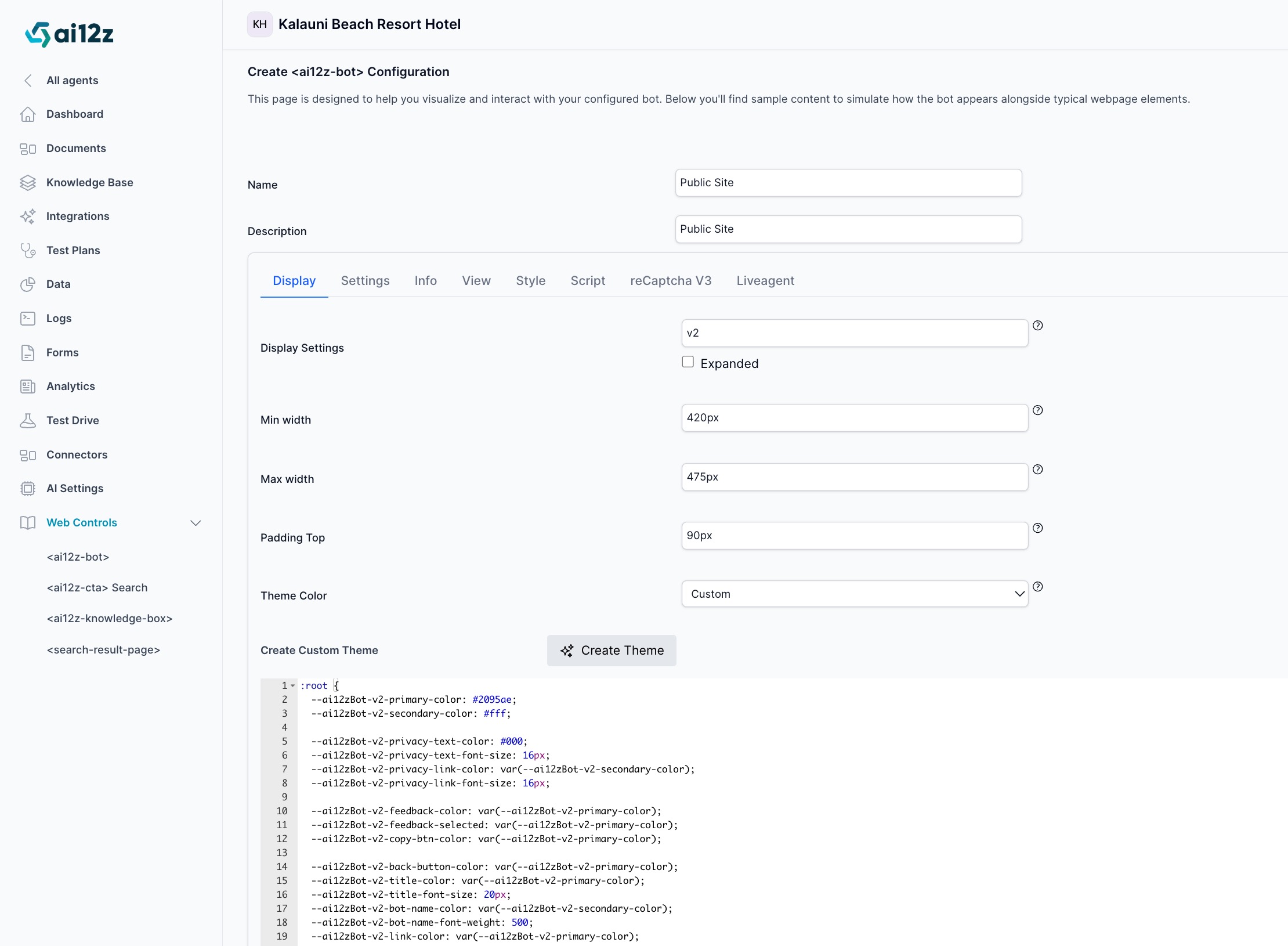
Name: Name your configuration. This is only used when displaying the list of configurations. The first configuration is typically named "Default".
Description: The description of the configuration. This is only used when displaying the list of configurations and helps identify the purpose of each configuration.
Theme Selection
Choose your bot's visual theme from the dropdown list. The theme controls the overall appearance, colors, and styling of your bot interface.
Available Theme Options:
- Default Themes: Pre-built themes with standardized color schemes and styling
- Custom Theme: Create a personalized theme that matches your brand identity
Custom Theme Creation
When you select "Custom" from the theme dropdown, ai12z will automatically begin the theme creation process.
Important: Before creating a custom theme, we strongly recommend completing the AI Brand Creation process first. This will analyze your brand assets and automatically generate appropriate colors, fonts, and styling guidelines that will be used in your custom theme.
To create a custom theme:
-
Complete Brand Guidelines First (Recommended)
- Navigate to AI Settings → Brand Guidelines
- Follow the AI Brand Creation guide to upload your brand images
- Generate and save your brand guidelines
-
Select Custom Theme
- Return to your bot configuration
- Choose "Custom" from the Theme dropdown
- The system will automatically create a theme based on your saved brand guidelines
-
Theme Auto-Generation
- If you have completed brand guidelines, the custom theme will automatically inherit:
- Primary and secondary brand colors
- Accent colors for highlights and interactions
- Typography preferences
- Overall visual style consistency
- If no brand guidelines exist, a default custom theme template will be created that you can manually customize
- If you have completed brand guidelines, the custom theme will automatically inherit:
Benefits of Custom Theme with Brand Guidelines:
- Brand Consistency: Automatically matches your website's visual identity
- Professional Appearance: Cohesive design that reflects your brand personality
- Time Saving: No manual color picking or style configuration needed
- Responsive Design: Optimized for all device sizes while maintaining brand integrity
Display tab
Manage the width and height of the Bot, and the mode of how the Bot opens. The check box for Expanded view, changes the behavior of the Bot when the page loads. If unchecked it will display as
Expanded view Checked

Expanded view Unchecked
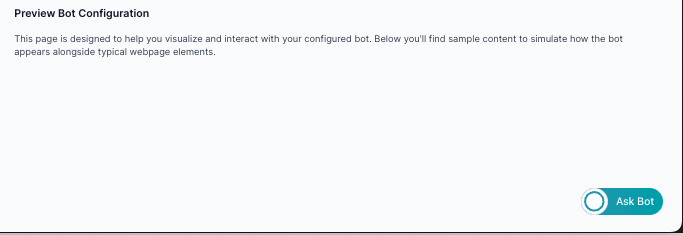
Settings tab
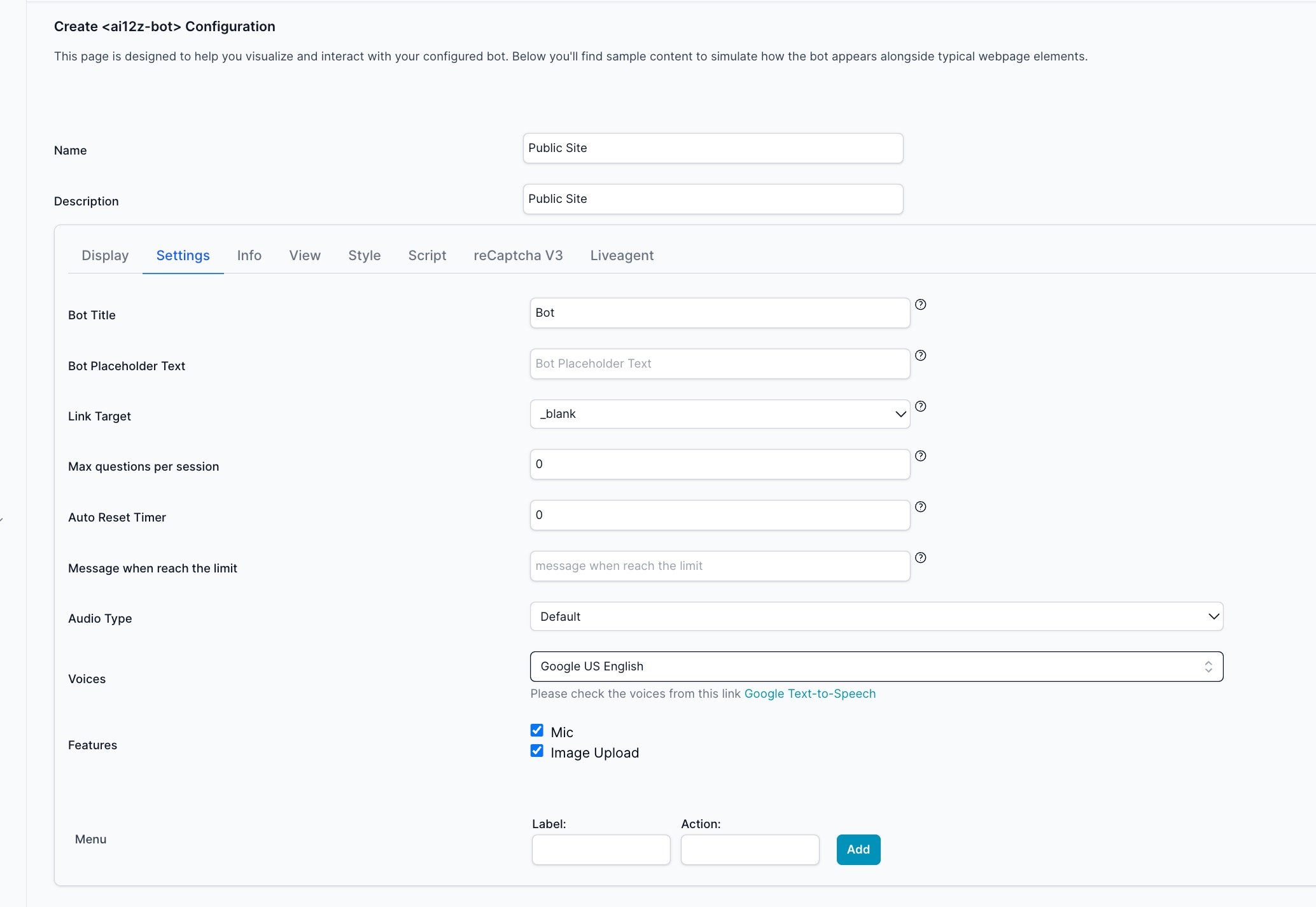
- Bot Title Naming your Bot, this will show up when the Agent responds to the user
Preventing Chatbot Abuse and Token Drain
Overview
If a public-facing chatbot is targeted by automated spam (bots/scripts), it can generate a large number of rapid AI requests and consume tokens. ai12z provides two primary controls to mitigate this:
- Max Questions per Session (hard usage cap)
- reCAPTCHA v3 (bot detection and blocking before AI calls)
Used together, they significantly reduce the risk of runaway token usage.
Control 1: Max Questions per Session
What it does
Max Questions per Session sets a hard ceiling on how many questions a single chat session can send to the AI. Once the limit is reached, the bot stops issuing additional AI requests, preventing further token spend from that session.
Why it prevents token drain
Even if a bot attempts to spam the chat UI, it cannot generate unlimited AI calls within the same session—usage is capped.
Where to configure
In your <ai12z-bot> configuration:
- Go to Settings
- Set Max questions per session
- (Optional) Set Message when reach the limit (recommended for clear UX)
- (Optional) Configure Auto Reset Timer to reset the session after a defined period of inactivity (or leave at
0if you want the cap to effectively require a new session)
Recommended settings (baseline)
- Max questions per session:
10–25(start at 20 for most sites) - Message when reach the limit: “You’ve reached the question limit for this session. Please try again later.”
- Auto Reset Timer:
30–60 minutes(or0if you prefer stricter behavior)
Control 2: reCAPTCHA v3
What it does
reCAPTCHA v3 helps detect automated traffic and assigns a risk score. Low-trust requests can be blocked or restricted before the chatbot sends an AI request.
Why it helps
reCAPTCHA reduces the chance that scripted traffic can repeatedly trigger AI calls, which protects against rapid token drawdown.
Where to configure
In your <ai12z-bot> configuration:
- Open the reCaptcha V3 tab
- Enable reCAPTCHA v3 and enter the required reCAPTCHA settings (e.g., keys) as prompted
- Apply the recommended scoring/allow rules for your environment
Recommended approach (baseline)
- Turn on reCAPTCHA v3 for any bot exposed on a public site
- Start with a moderate threshold and tighten if you see abuse (exact threshold depends on your site traffic patterns)
Best Practice: Use Both Together
- Max Questions per Session guarantees a hard stop per session.
- reCAPTCHA v3 reduces automated traffic before it becomes token spend.
Together, they provide strong protection against common “spam the chatbot” abuse patterns.
Info tab
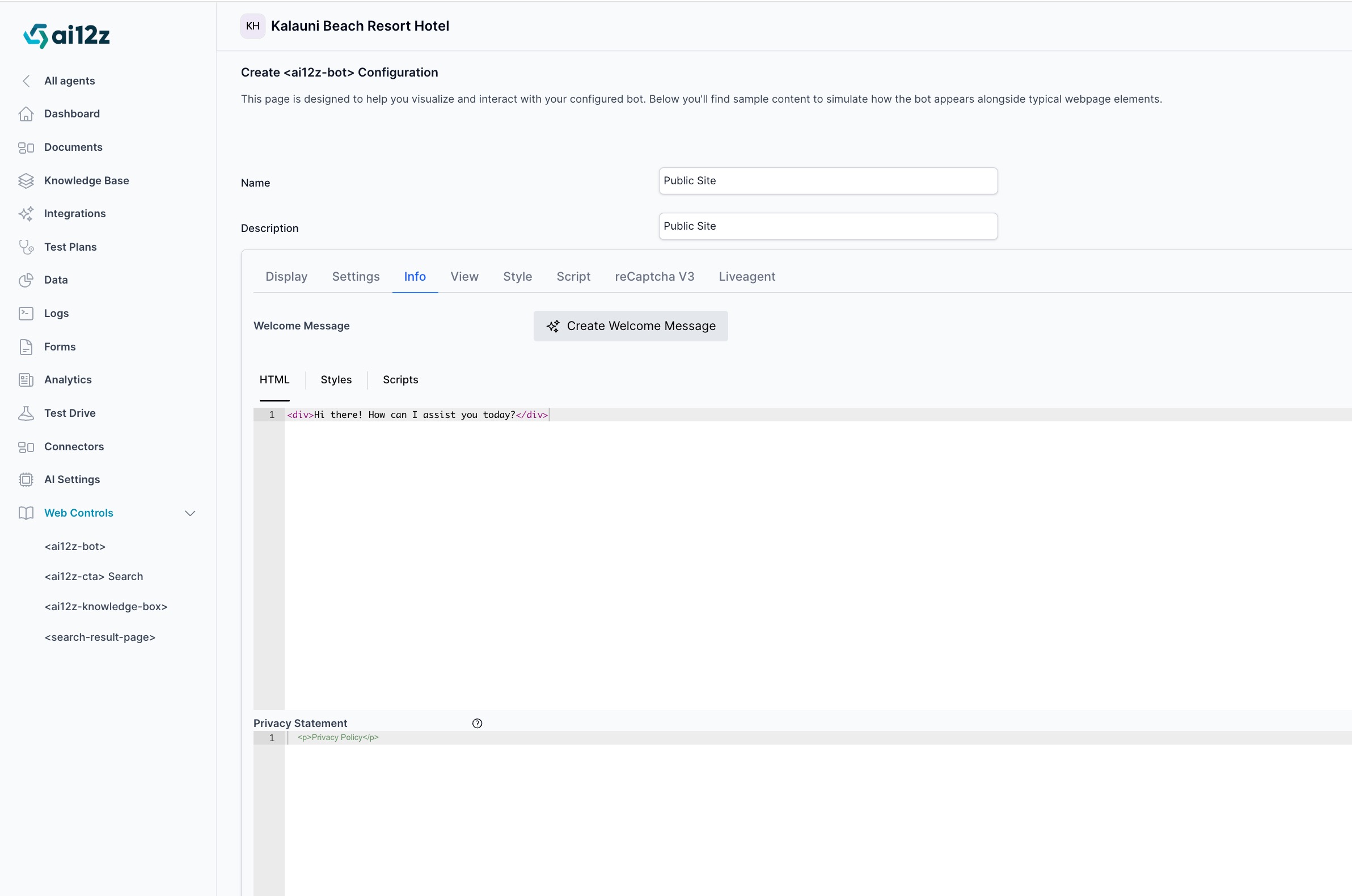
The Info tab allows you to customize the content that users see when they first interact with your bot. This includes welcome messages and privacy information.
Welcome Message
The Welcome Message appears when the bot first opens and provides the initial user experience. You can insert custom HTML content including:
- Text and Formatting: Use HTML tags for styled text, headings, and paragraphs
- Interactive Buttons: Add buttons that trigger specific bot actions
- Images and Media: Include logos, icons, or branded graphics
- Custom Styling: Apply CSS classes for brand-consistent appearance
- JavaScript Integration: Use
sendMessage()andsendJSON()functions for interactive elements
Example Welcome Message HTML:
<div class="welcome-container">
<h2>Welcome to Our Support Assistant!</h2>
<p>
I'm here to help you with your questions. Choose an option below or ask me
anything:
</p>
<button onclick="ai12zBot.sendMessage('I need help with billing')">
Billing Support
</button>
<button onclick="ai12zBot.sendMessage('Technical support')">
Technical Help
</button>
</div>
Privacy Statement
The Privacy Statement displays privacy information to users, typically as a brief notice with a link to your full privacy policy. Keep this concise and user-friendly.
Best Practices for Privacy Statement:
- Keep the message short and clear
- Link to your complete privacy policy page
- Include essential information about data collection
- Use reassuring language about data protection
Example Privacy Statement:
<p>
Your privacy is important to us. We collect minimal information to provide
better assistance.
<a href="/privacy-policy" target="_blank">View our Privacy Policy</a>
</p>
AI Create Welcome Page
The AI Create Welcome Page feature automatically generates personalized welcome content based on your website and business context.
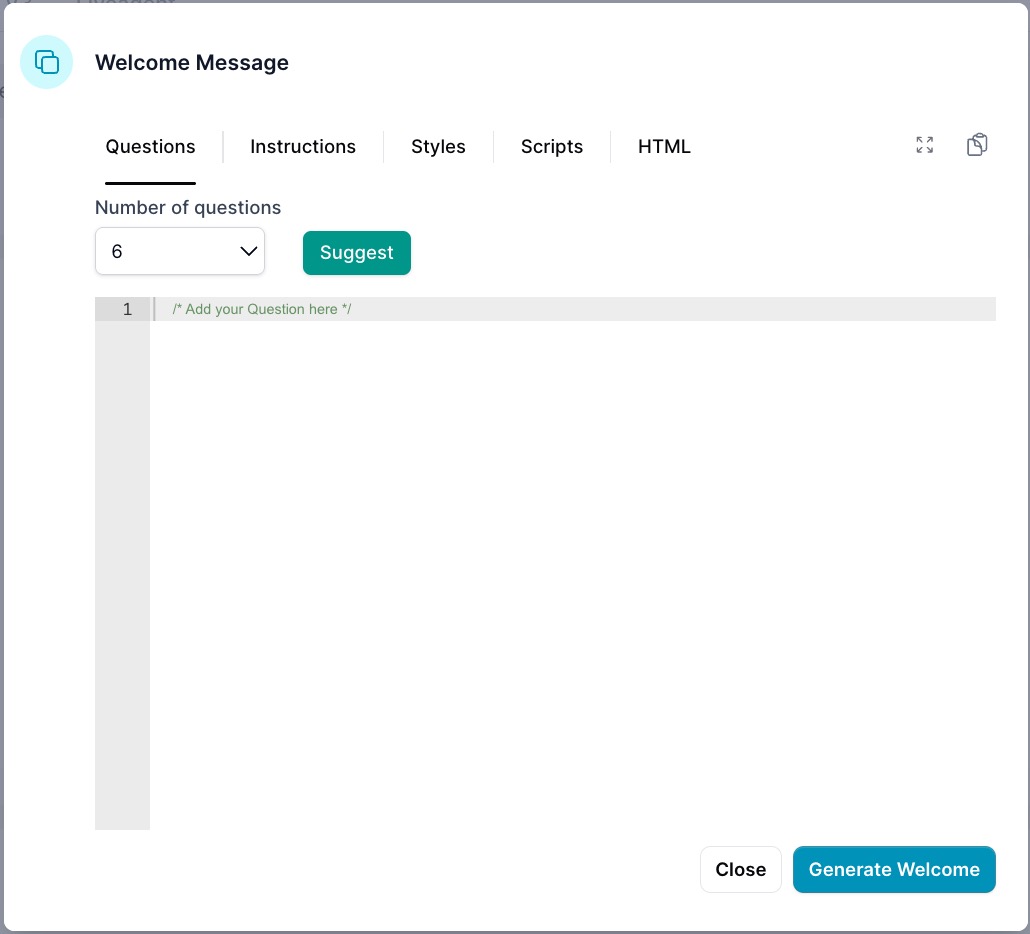
How It Works
- Domain Analysis: The system uses the domain from your agent settings
- Content Intelligence: LLM analyzes your website content and knowledge base
- Question Generation: Creates relevant questions your visitors commonly ask
- Contextual Suggestions: Tailors questions to specific website sections (if specified)
Using Advanced Settings
Advanced Tab Options:
- Section Targeting: Specify a particular section of your website to focus question generation
- Content Context: Provide additional context about your business or service area
- Question Types: Choose between general questions, product-specific, or support-focused
Example Advanced Settings:
- Target Section: "Products > Software Solutions"
- Context: "Enterprise software for healthcare providers"
- Focus: "Implementation and support questions"
Click Generate Welcome
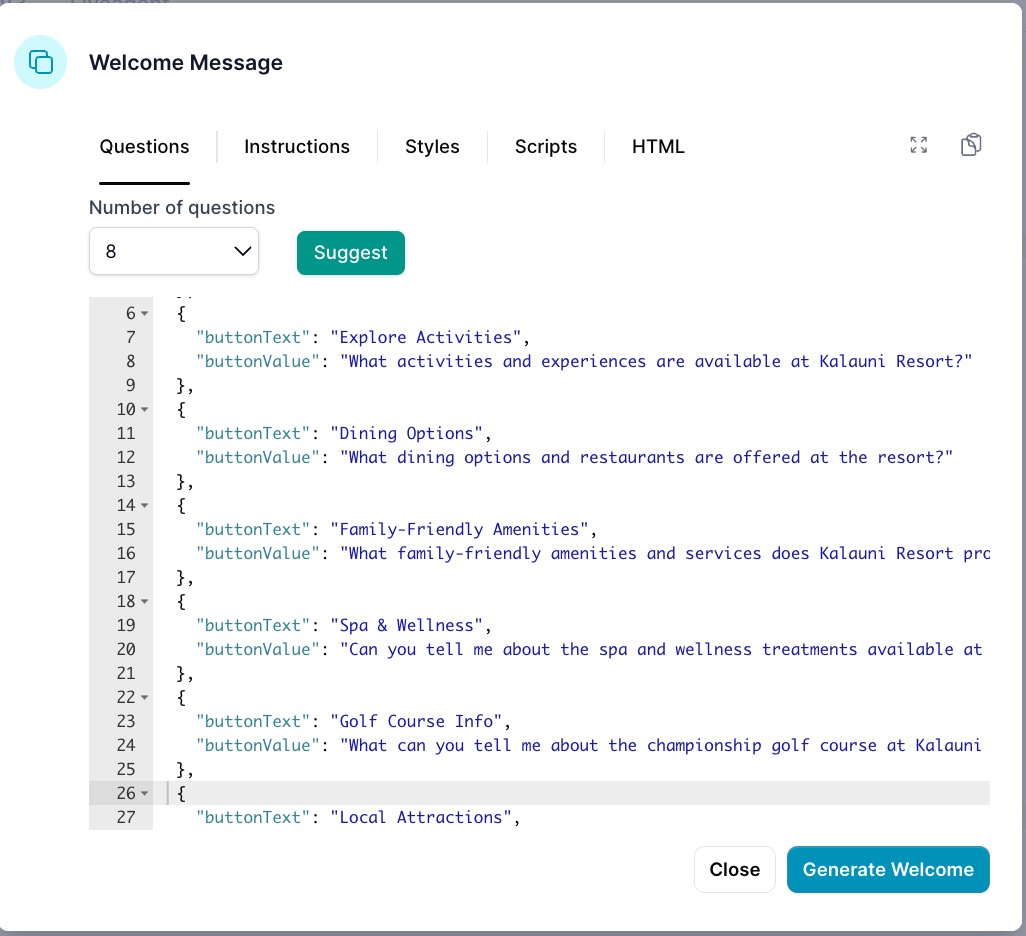
When you click "Generate Welcome", the AI will create:
Generated Content:
- HTML Structure: Properly formatted welcome message with your brand context
- CSS Styling: Responsive design that works across devices
- JavaScript Functions (if required): Interactive elements for enhanced user engagement
- Suggested Questions: Relevant questions as clickable buttons or quick actions
Content Elements Created:
- Welcome greeting personalized to your business
- 3-5 relevant question buttons
- Professional formatting with your brand context
- Mobile-responsive design
- Accessibility-friendly structure
Save and Iterate
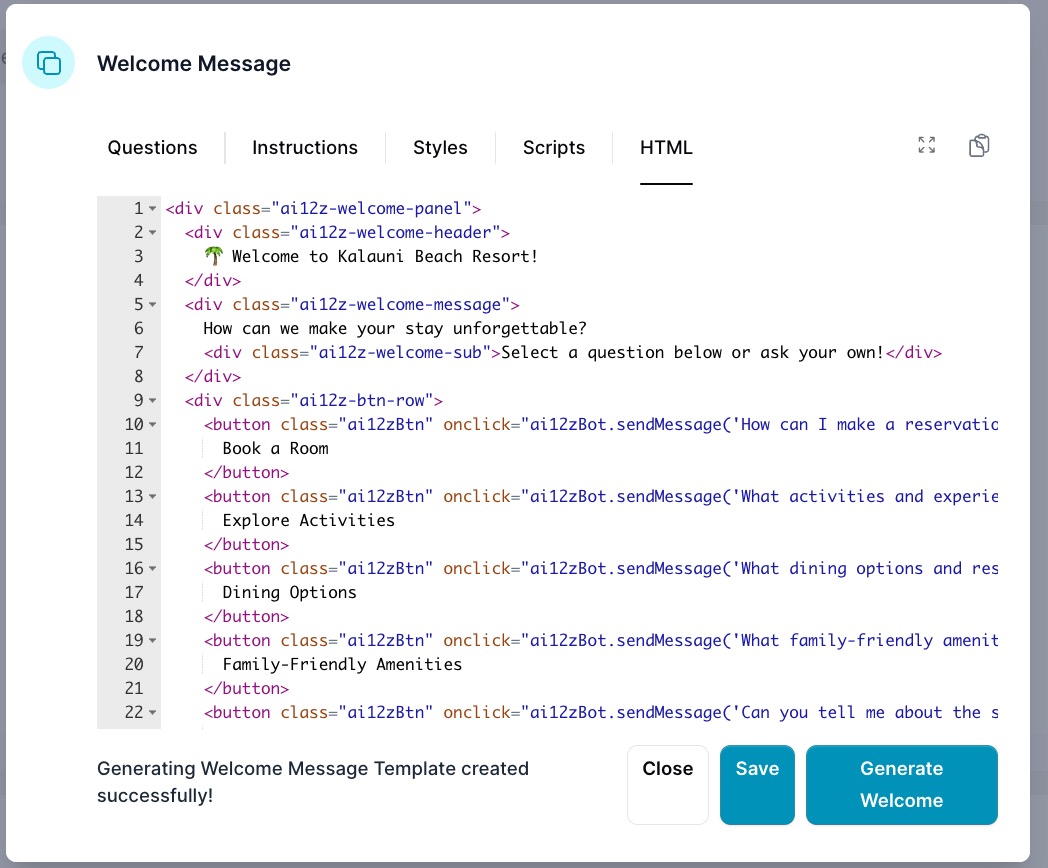
After generation, you can:
Review Generated Content:
- Preview the welcome message layout
- Test question buttons functionality
- Verify brand consistency and tone
Customize Further:
- Add specific instructions for refinement
- Request different question types
- Modify styling or layout preferences
- Include additional interactive elements
Iterate the Process:
- Click "Generate" again with new instructions
- Refine based on testing feedback
- Add seasonal or promotional content
- Update questions based on user behavior analytics
Save Your Welcome Message:
- Click "Save" to apply the generated content
- The welcome message becomes active immediately
- Test the bot to ensure proper functionality
- Monitor user interactions and adjust as needed
Best Practices for AI-Generated Welcome Messages
Content Strategy:
- Use business-specific context for better question generation
- Include your most common customer inquiries
- Balance promotional content with helpful information
- Keep language consistent with your brand voice
Technical Considerations:
- Test generated JavaScript functions thoroughly
- Ensure mobile responsiveness across devices
- Verify accessibility compliance
- Monitor loading performance with media elements
Ongoing Optimization:
- Regularly review question effectiveness through analytics
- Update seasonal or promotional content
- Refine based on user feedback and behavior
- A/B test different welcome message approaches
View tab
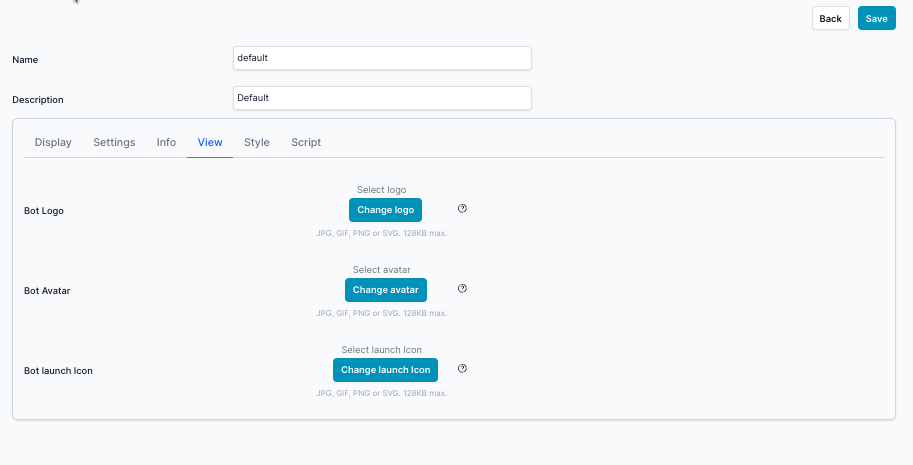
By default none are needed.
Style tab
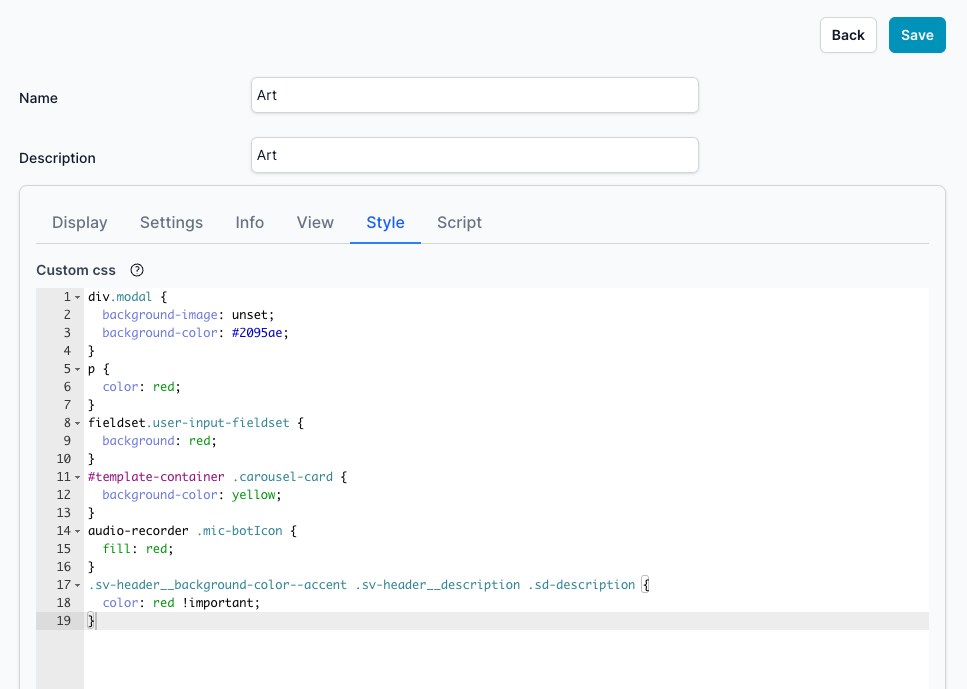
div.modal {
background-image: unset;
background-color: #2095ae;
}
p {
color: red;
}
fieldset.user-input-fieldset {
background: red;
}
#template-container .carousel-card {
background-color: yellow;
}
audio-recorder .mic-botIcon {
fill: red;
}
.sv-header__background-color--accent .sv-header__description .sd-description {
color: red !important;
}
Script tab
Note all integrations and even welcome message have there own script tab. Put general purpose script here.
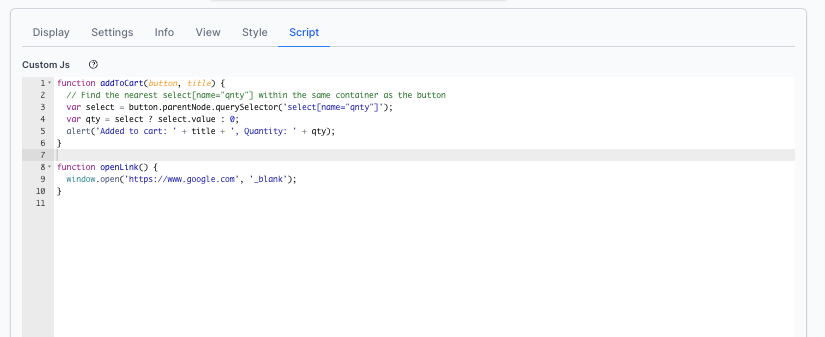
ai12z runs in a shadow dom, so to access a function it will not work if it exists in a js file.
The code below will not work
<input type="text" id="myTextField" value="hello" /> const textField =
document.getElementById('myTextField');
In a shadow dom, you need to access using querySelector
-
- First, get the host element (the element to which the shadow root is attached).
-
- Then, access the shadow root via .shadowRoot.
-
- After that, use regular DOM methods (like .querySelector) inside the shadow root.
Accessing and Manipulating HTML Elements in ai12z Bot Custom Scripts
ai12z allows you to add custom JavaScript functions to your bot for actions such as “Add to Cart,” opening links, or interacting with the page. When your function needs to interact with HTML elements (such as reading the value of a dropdown), you need to reference those elements relative to the button or UI element that triggered your script.
Example: Add to Cart Button With Quantity
Suppose you have an "Add to Cart" button and a quantity dropdown in your UI. You want your script to:
- Find the quantity selected by the user, and
- Show a confirmation with the title and selected quantity.
Here’s how you can do this:
function addToCart(button, title) {
// Find the nearest select[name="qnty"] within the same container as the button
var select = button.parentNode.querySelector('select[name="qnty"]')
var qty = select ? select.value : 0
alert("Added to cart: " + title + ", Quantity: " + qty)
}
How it works:
buttonis a reference to the button element that was clicked (passed by the bot’s event system).button.parentNodegets the container (parent) of the button..querySelector('select[name="qnty"]')looks for the<select>dropdown for quantity within that container.select.valuegets the selected quantity value.
This pattern ensures your script only accesses the dropdown that belongs to the same “card” or UI block as the button clicked—avoiding confusion if there are multiple product cards on the page.
General Guidance for Accessing HTML Elements
- Always use the button or element that triggers your function as the starting point.
- Use
parentNode,closest(), or other DOM traversal methods to reliably locate the relevant input, dropdown, or other element. - Avoid using
document.querySelectorglobally unless there is only ever one matching element—otherwise, you might get the wrong one!
Example: Open Link in a New Tab
function openLink() {
window.open("https://www.google.com", "_blank")
}
Best Practices
- Keep selectors specific to the UI structure: Use
parentNodeor.closest()to scope your queries to the right container. - Check for nulls: Always check if the element exists before using its value.
- Use clear, descriptive function names: So it’s obvious what each script does when editing later.
Summary
When writing custom JavaScript for ai12z bot controls:
- Functions can be called by the bot when events occur (like button clicks).
- To access UI fields, use the triggering element as a reference point and traverse the DOM as needed.
- This keeps your code robust even when there are many interactive elements on the page.